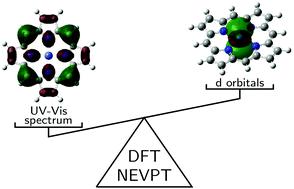当前位置:
X-MOL 学术
›
Phys. Chem. Chem. Phys.
›
论文详情
Our official English website, www.x-mol.net, welcomes your
feedback! (Note: you will need to create a separate account there.)
Can one use the electronic absorption spectra of metalloporphyrins to benchmark electronic structure methods? A case study on the cobalt porphyrin
Physical Chemistry Chemical Physics ( IF 2.9 ) Pub Date : 2020-10-09 , DOI: 10.1039/d0cp04699j Jhonathan Rosa de Souza 1, 2, 3, 4, 5 , Matheus Morato F. de Moraes 2, 3, 4, 6, 7 , Yuri Alexandre Aoto 2, 3, 4, 6, 7 , Paula Homem-de-Mello 1, 2, 3, 4, 5
Physical Chemistry Chemical Physics ( IF 2.9 ) Pub Date : 2020-10-09 , DOI: 10.1039/d0cp04699j Jhonathan Rosa de Souza 1, 2, 3, 4, 5 , Matheus Morato F. de Moraes 2, 3, 4, 6, 7 , Yuri Alexandre Aoto 2, 3, 4, 6, 7 , Paula Homem-de-Mello 1, 2, 3, 4, 5
Affiliation

|
In this article, we describe calculations on the absorption spectrum of cobalt(II) porphyrin, using density functional (DFT) and multireference n-electron valence perturbation (NEVPT) theories. With these calculations, we describe the lowest-energy states of doublet and quartet spin multiplicities, the excited states that originate the Q and B bands of porphyrins, some higher-energy π–π* excitations and charge-transfer states, HOMO–LUMO gaps, and ionisation potentials. Results undoubtedly show that the position of B band is essentially independent on the DFT functional, while the Q band is better described by pure functionals, and these bands do not depend on the initial state of the transition (whether doublet or quartet) as well. However, other excitation energies, orbital energies, and ionisation potentials strongly depend on the functional, in some cases varying more than 2 eV. Based on these results we conclude that one should not use the UV-Vis spectrum of metalloporphyrins to benchmark density functionals, mainly those properties related to coordination with the metallic ion. Furthermore, the results show that functionals that yield correct spectra may be based on an incorrect ground state description. Moreover, we reinforce that one must be skeptical about the reference chosen to benchmark electronic structure calculations, such as DFT functionals and active spaces for multireference calculations.
中文翻译:

能否使用金属卟啉的电子吸收光谱作为基准电子结构方法?钴卟啉的个案研究
在本文中,我们描述了钴吸收光谱的计算(II)卟啉,使用密度泛函(DFT)和多参考n电子价态扰动(NEVPT)理论。通过这些计算,我们描述了双重态和四重态自旋多重性的最低能态,形成卟啉Q和B带的激发态,一些较高能的π–π *激发和电荷转移态,HOMO–LUMO间隙以及电离势。结果无疑表明,B波段的位置基本上与DFT功能无关,而Q波段可以用纯功能更好地描述,并且这些波段也不取决于过渡的初始状态(无论是二重态还是四重态)。但是,其他激发能,轨道能和电离能强烈地取决于功能,在某些情况下变化超过2 eV。根据这些结果,我们得出结论,不应使用金属卟啉的UV-Vis光谱作为基准的密度泛函,主要是那些与金属离子配位有关的性质。此外,结果表明产生正确光谱的功能可能基于错误的基态描述。此外,我们强调必须对选择用来基准化电子结构计算的参考物持怀疑态度,例如DFT功能和用于多参考物计算的有效空间。
更新日期:2020-10-19
中文翻译:

能否使用金属卟啉的电子吸收光谱作为基准电子结构方法?钴卟啉的个案研究
在本文中,我们描述了钴吸收光谱的计算(II)卟啉,使用密度泛函(DFT)和多参考n电子价态扰动(NEVPT)理论。通过这些计算,我们描述了双重态和四重态自旋多重性的最低能态,形成卟啉Q和B带的激发态,一些较高能的π–π *激发和电荷转移态,HOMO–LUMO间隙以及电离势。结果无疑表明,B波段的位置基本上与DFT功能无关,而Q波段可以用纯功能更好地描述,并且这些波段也不取决于过渡的初始状态(无论是二重态还是四重态)。但是,其他激发能,轨道能和电离能强烈地取决于功能,在某些情况下变化超过2 eV。根据这些结果,我们得出结论,不应使用金属卟啉的UV-Vis光谱作为基准的密度泛函,主要是那些与金属离子配位有关的性质。此外,结果表明产生正确光谱的功能可能基于错误的基态描述。此外,我们强调必须对选择用来基准化电子结构计算的参考物持怀疑态度,例如DFT功能和用于多参考物计算的有效空间。










































 京公网安备 11010802027423号
京公网安备 11010802027423号